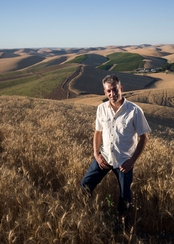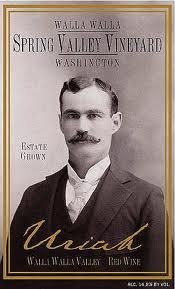Considering its relatively small population (about 30,000), and considering how far it is from any major metropolitan center (about 4 hours to get to Seattle or Portland), it strikes me that Walla Walla has attracted a disproportionate number of French vignerons plying their trade in this bucolic corner of Washington state. They hail from almost  every winemaking region of France, including Provence (Virginie Bourgue), Burgundy (Eve-Marie Gilla) and Champagne (Christophe Baron). And then there’s Serge Laville, a native of–wait, Paris? Paris is no viticultural region! But not to worry, Serge had enough hands-on experience as a youngster working in his grandfather’s Côtes du Rhône winery to qualify as a véritable onologue français, a true French winemaker.
every winemaking region of France, including Provence (Virginie Bourgue), Burgundy (Eve-Marie Gilla) and Champagne (Christophe Baron). And then there’s Serge Laville, a native of–wait, Paris? Paris is no viticultural region! But not to worry, Serge had enough hands-on experience as a youngster working in his grandfather’s Côtes du Rhône winery to qualify as a véritable onologue français, a true French winemaker.
In 2000 Serge Laville visited the United States. He came as a tourist, travelling around the country with backpack and camera, but when he  reached Walla Walla a chance meeting with Spring Valley Vineyard’s founding winemaker, Devin Corkrum Derby changed the course of his life. Serge fell in love with the region, the wines, and the woman who would ultimately become his wife. He started working with Devin at Spring Valley (the site had been homesteaded by Devin’s ancestor, Uriah Corkrum, in 1866). Serge’s first Spring Valley harvest was in 2002, then, in 2004, after Devin Derby’s untimely death, he took over the winemaking responsibilities. In 2005, Ste. Michelle Wine Estates leased the vineyard and winery and purchased the Spring Valley Vineyard wine brand from the Derby family. The wines, under Serge’s care, continue to be superb, winning raves and high scores from significant wine reviewers everywhere (at Wine Review Online Michael Apstein awarded 2003 “Uriah Red” 93 points).
reached Walla Walla a chance meeting with Spring Valley Vineyard’s founding winemaker, Devin Corkrum Derby changed the course of his life. Serge fell in love with the region, the wines, and the woman who would ultimately become his wife. He started working with Devin at Spring Valley (the site had been homesteaded by Devin’s ancestor, Uriah Corkrum, in 1866). Serge’s first Spring Valley harvest was in 2002, then, in 2004, after Devin Derby’s untimely death, he took over the winemaking responsibilities. In 2005, Ste. Michelle Wine Estates leased the vineyard and winery and purchased the Spring Valley Vineyard wine brand from the Derby family. The wines, under Serge’s care, continue to be superb, winning raves and high scores from significant wine reviewers everywhere (at Wine Review Online Michael Apstein awarded 2003 “Uriah Red” 93 points).
I recently had occasion to attend a vertical tasting of Spring Valley’s “Uriah” series, a Merlot-based blend named for Uriah Corkrum, who first homesteaded the land that became Spring Valley. The 40 acre Spring Valley Vineyard, at an elevation of 1,200 to 1,500 feet), has vine-friendly clay and volcanic soils. The temperatures at this altitude tend to be cooler during the growing season, which helps the grapes to develop zingy acidity and also allows them to ripen on the vine longer than other places. “When the rest of Walla Walla has finished harvesting is usually when Spring Valley starts picking,” says Serge Laville.
Valley Vineyard, at an elevation of 1,200 to 1,500 feet), has vine-friendly clay and volcanic soils. The temperatures at this altitude tend to be cooler during the growing season, which helps the grapes to develop zingy acidity and also allows them to ripen on the vine longer than other places. “When the rest of Walla Walla has finished harvesting is usually when Spring Valley starts picking,” says Serge Laville.
Spring Valley’s first vintage, 1999, still shows remarkable amounts of fresh fruit, but it lacks complexity and has dulled somewhat over the years. Or perhaps it never did truly shine, and has evolved into greatness over the years as the vines matured and the winemaking gained expertise. 2003 was a gorgeous vintage. The wine, a blend of 77% Merlot, 22% Cabernet Franc and 2% Petit Verdot, is loaded with delectable dark fruit, hints of chocolate, and a trail of luscious, soft tannins. The superlative 2004 is the only one that includes Cabernet Sauvignon in the blend (about 5%), which kicks the power up a notch and adds firmness to the tannins without in any way sublimating the wine’s structure or inherent fruit-laced deliciousness.
If I had to pick a favorite vintage it might be the 2006, possibly because of the intensity of its fruity, floral fragrance. It includes 6% Malbec as well as Merlot, Cab Franc and Petit Verdot. 2006 was an almost perfect growing season, dominated by a hot, dry summer and a long, mild ripening period that lasted all the way into October, and resulted in small berries loaded with sweet, condensed flavors. The 2007 Uriah seems almost too young to really evaluate, though its good structure and balance are obvious, with freshness and elegance its most significant features right now. Each of the Uriah wines costs about $50. Only a few thousand cases are made each year, so tracking them down is a bit of a treasure hunt. The bottom line: Walla Walla oui! oui!
7
